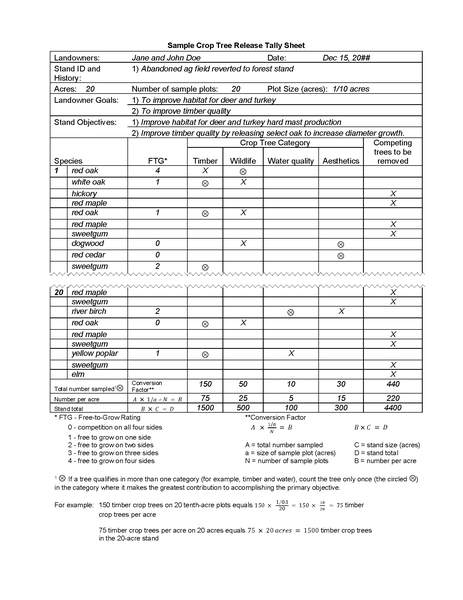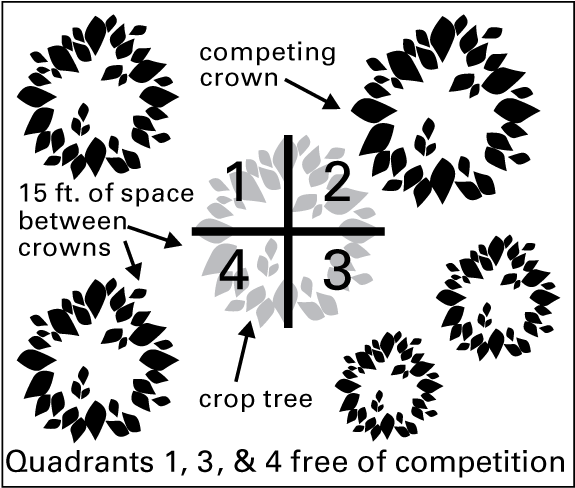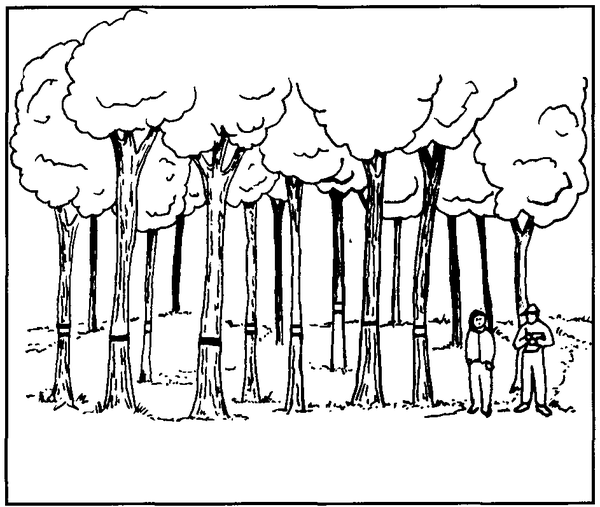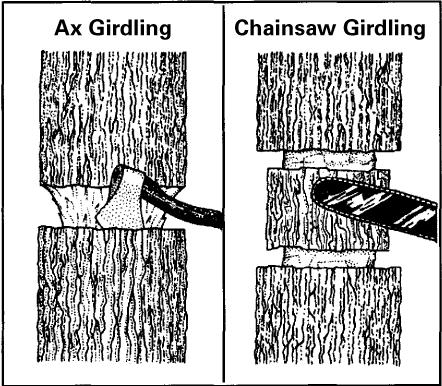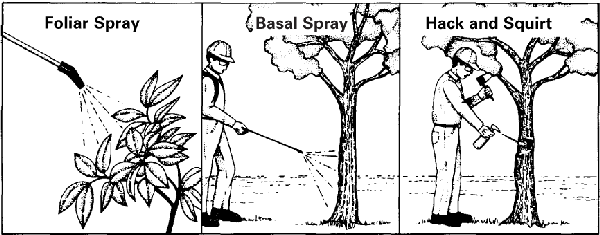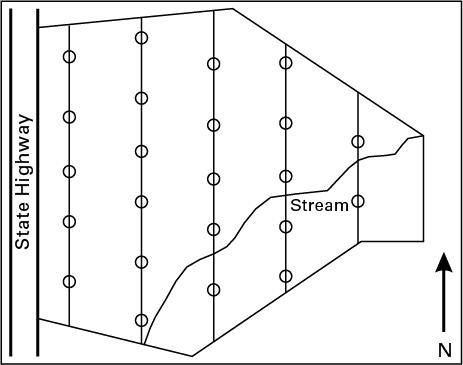Landowners today are interested in forest management that promotes environmental stewardship and produces multiple benefits. Crop tree management can do just that. This system is designed for use in timber stands of adequate quality, but which are either not ready for final harvest and regeneration or belong to landowners who place high value on continuing stand management.
Crop tree management is a seven-step system that focuses on releasing trees that yield multiple benefits (including wildlife, water quality, and aesthetics, as well as timber) through intermediate cutting treatments around crop trees with the highest potential increase in value. Crop tree management requires making decisions about individual trees rather than an entire stand or forest.
Crop tree management was developed for use on nonindustrial private forests of the Eastern United States. Small, natural, mixed hardwood stands (generally 100 acres or less) are well suited to this method of management, and it works particularly well in areas such as riparian zones, urban and community woodlots, and forest buffers. Crop tree management can be used in precommercial as well as commercially operable stands.
This publication introduces readers to the seven steps involved in implementing crop tree management. The publication is tailored to Southeast species, objectives, and forest conditions and explains how the approach might be applied to trees for wildlife, water quality, timber, and aesthetics.
Crop tree management is an intermediate stand management strategy, like thinning. So, what makes crop tree management different from typical thinning? Area-wide thinning, especially mechanized thinning, at its best takes out most of the poor trees, retaining most of the good trees for future harvest. The trees retained in an area-wide thinning are evenly spaced (for example, a target of 12- x 12-foot spacing, or the removal of periodic rows). Generally, most of the emphasis in area-wide thinning is on the trees to be removed and the reasons for their removal. This is just the reverse of crop tree management, which focuses on retaining and managing the "best" trees with the greatest potential to produce specific benefits consistent with the landowner's goals for the property. Crop tree management singles out and "releases" only the "best" trees, regardless of their spacing or location. This release requires the removal of just those noncrop trees that are in direct crown competition with the selected crop trees. Crop tree management applies a “crown touching release"—removing or killing all trees with crowns that interfere with the crop tree. This is likely to result in an unequal distribution of free-to-grow, desirable crop trees throughout the stand.
The process of crop tree management can be labor intensive and expensive. Some timber tradeoffs to enhance amenities such as beauty, wildlife habitat, and recreation may be highly desirable. Prudent investors and managers will weigh these alternative opportunities and choose the combination that yields the greatest return in satisfaction as well as economics. Research has shown that crop tree management can produce multiple benefits including timber, wildlife, and aesthetics, and still generate attractive economic returns.
Responses to management inputs and returns on forestry investments vary with site quality, tree growth, timber quality, markets, and many other factors. In North Carolina, crop tree management opportunities are most attractive on sites with high potential productivity (and responsiveness). In general, these are likely to include natural mixed hardwood and pine-hardwood stands on red river bottoms, branch bottoms, coves, lower slopes, and other deep, well-drained alluvial soils.
Crop Tree Management - The Process
Step 1. Identifying the Landowner's Property Goals
The first step in crop tree management is to identify the landowner's goals for a given property. This can be accomplished by answering the question “What uses are intended for this forestland?" Goals should address both long-term and immediate desires and can take the form of statements about future conditions. In all cases, goals should be consistent with the ultimate reason for owning the land. They must be realistic and achievable, and they must be compatible with the resources available. Examples of goals include:
- Enhance recreational suitability of the property
- Enhance the beauty of the property around the house and road
- Improve deer and turkey habitat for hunting
Step 2. Establish Stand-Specific Objectives
By developing stand-specific objectives, attention is focused on the stands with the greatest potential to help the landowner achieve overall property goals. Not every stand has the same (or even any) potential to accomplish property goals. For example, improving squirrel habitat by increasing hard mast production may not be possible or practical in a pure yellow-poplar cove, but could be addressed on a nearby oak-hickory ridge. Objectives are specific actions or steps that lead toward the accomplishment of goals. Keep in mind that objectives must be specific to be effective. Examples of specific objectives are:
- Improve deer habitat by increasing hard-mast production in oak and hickory
- Improve recreational access by turning an old logging road into a hiking trail
- Increase the variety of fall colors that can be seen from the road or house
Step 3. Develop Crop Tree Selection Criteria
Crop tree selection criteria are developed to match specific objectives. Examples of some (timber, wildlife, aesthetic, and water quality) crop tree selection criteria are included in Table 1. Like the objectives, the selection criteria may differ from stand to stand, and selection criteria are almost certain to vary among landowners. Crop tree selection criteria should be designed to guide the selection of potential crop trees. Any tree meeting multiple selection criteria would be especially desirable because it is achieving multiple objectives.
| Timber | Dominant / codominant trees |
|
|---|---|---|
| Wildlife | Mast-producing trees |
|
| Cavity trees |
|
|
| Aesthetic | Attractive flowers or colorful foliage |
|
| Water Quality | Dominant / codominant trees |
|
Crop trees are those trees that best meet the tree selection criteria and thereby accomplish one or more stand objectives, leading toward the satisfaction of landowner goals. Conflicts may occur among criteria, and judgment must be exercised. Give priority to one particular crop tree in each case, or weigh external factors such as site or tree characteristics or the degree to which a criterion is satisfied by crop trees elsewhere in a stand. A tree that might not qualify as a crop tree in one spot could be the best tree available in another. When selecting crop trees, pick the best tree available in each case. Table 2 provides a general list of common tree species and some of the benefits they frequently provide.
| Species | Benefit Capability | |||
|---|---|---|---|---|
| Timber | Wildlife | Aesthetics | Water Quality | |
| ash | + | + | + | |
| bald cypress | + | + | + | |
| basswood | + | + | + | |
| beech | + | + | ||
| black cherry | + | |||
| blackgum | + | + | + | + |
| cucumber | + | + | + | |
| dogwood | + | + | ||
| elm | + | + | ||
| hemlock | + | + | ||
| hickory | + | |||
| holly | + | + | ||
| hophornbeam | + | + | ||
| maple | + | + | ||
|
oak (red) |
||||
| black | + | + | + | |
| cherrybark | + | + | + | |
| laurel | + | + | + | |
| live | + | + | + | + |
| northern red | + | + | ||
| southern red | + | + | ||
| scarlet | + | + | + | |
| water | + | + | + | |
| willow | + | + | + | |
|
oak (white) |
||||
| white | + | + | ||
| chestnut | + | |||
| swamp chestnut | + | + | + | |
| persimmon | + | + | ||
|
pine |
||||
| loblolly | + | + | ||
| longleaf | + | + | + | |
| shortleaf | + | + | ||
| virginia | + | |||
| white | + | + | ||
| red cedar | + | + | + | |
| river birch | + | + | ||
| sassafras | + | |||
| sourwood | + | + | ||
| southern magnolia | + | + | ||
| sweetgum | + | + | ||
| sycamore | + | + | + | |
| yellow poplar | + | + | + | |
Step 4. Inventory the Property
Inventory the selected stand or property to determine whether enough crop trees meet the selection criteria (see Appendix A). By using a systematic cruise and tally sheet(s) similar to the one in this publication (see sample in Figure 1 and Appendix B), the landowner can determine how many crop trees there are per acre or per stand and how many trees should be cut to release the crop trees. Most landowners should expect to find one to several-hundred crop trees per acre. Higher numbers imply more work, higher cost, and heavier harvest levels than may be justified. Lower numbers may not represent good use of the land and indicate stands that should be managed by some other strategy or should be regenerated completely.
A typical crop tree inventory would include information about species, category of crop tree (selection criterion), free-to-grow (FTG) rating (see Step 6), and information on leave and cut trees. Figure 1 shows a sample tally sheet.
Step 5. Decide How Many Crop Trees to Release per Acre
The number of crop trees to be released per acre depends on the number of trees meeting the criteria and how heavily the stand is to be cut. Whatever the number of crop trees to be released per acre, each crop tree should receive a complete crown touching release. Note that some areas or stands simply may not have enough crop trees to justify management by this method. In such cases, alternative management strategies including complete regeneration may be more appropriate.
Step 6. Decide which Trees to Cut to Release the Crop Trees
To determine which trees are to be cut, look up into the crown of the crop tree and divide the crown into four equal quadrants (Figure 2). Examine each quadrant to determine whether the crop tree has adequate space to grow (freedom from competing trees). This is known as determining the free-to-grow rating (FTG). The FTG can range from 0 to 4. A rating of “0” means the crop tree crown has competition from neighboring crowns on all four sides (is not free to grow), and an FTG rating of "4" means the crop tree has adequate space to grow on all four sides and needs no release. A crop tree is not free to grow in a quadrant if there is only 1 to 2 feet between the crop tree's crown and the neighboring crown. Assuming that a healthy tree crown might expand in radius 1 foot annually, the space between two competing crowns would decrease by 2 feet each year. At this rate, 15 feet between crowns would allow room for seven to eight years' growth. The ideal target of crown-touching release would be to give each crop tree an FTG of 3 or higher. Multiple entries into the stand over several years may be preferable to a single complete release of crop trees because of the risk of damage or degradation (such as that caused by storms or epicormic branching).
Step 7. Review the Proposed Treatment
Thoroughly review the stand-specific objectives for each stand, the crop tree selection criteria, and the number of crop trees to be released. Demonstrate the treatment (Figure 3) by setting up a few trial plots (1/5 acre, for example, would be a circular plot with a 52.7-foot radius). Flag the crop tree(s) with bright flagging. Mark competing trees to be cut with a different color flagging (those to be left can be marked with a third type of flagging if desired). Judge the heaviness of cutting either from flagged trees or after actual cutting on the trial plot(s). In crop tree management, only those trees directly competing with the crop trees need to be cut.
Those trees whose crowns do not directly compete with the identified crop trees remain in the stand. If a proposed cutting appears too heavy, reduce the number of crop trees selected for release rather than reducing the amount of release for each crop tree.
Crop Tree Release Techniques
If the competing trees to be removed have a marketable volume and value, seek help from a professional forester in marking, marketing, and harvesting the timber. If the trees to be cut are small or unsuitable for sale, they may be cut, felled, and left in place; girdled; or killed by an appropriate, labeled herbicide treatment. Mechanical girdling is the process of removing the cambium and bark from a ring around the trunk (Figure 4). This can be done with an ax or chainsaw. Using an ax, cut a band of bark and living tissue 3 to 5 inches wide in a circular pattern around the tree. Using a chainsaw, make two cuts, approximately 1 inch deep and 3 to 5 inches apart, in a circular pattern completely around the tree. This girdling treatment should interfere with the tree's ability to transport food. Herbicides, properly applied, can be safe, effective, and economical for controlling competing vegetation (Figure 5). Herbicides are designed for specific target species and conditions, so follow the directions on the label with respect to those conditions, timing, rate, and method of application to ensure effectiveness, personal safety, and environmental protection. Several common methods of application include foliar spray, basal spray, or squirted application to cuts through the bark (hacks or notches).
Summary
Crop tree management focuses on managing individual trees, expanding their potential to meet multiple landowner objectives. Crop tree management allows landowners to practice stewardship principles, retaining maximum control over stand conditions while accelerating progress toward multiple landowner benefits. Implementing crop tree management requires a clear understanding of property goals, establishment of appropriate stand-specific objectives, and development of suitable crop tree selection criteria. Selection of individual crop trees is guided both by the selection criteria and by desired stand conditions. A crown-touching release is applied around crop trees to free them from competition, thereby promoting accelerated growth and progress toward objectives. Crop tree management was developed primarily for small, natural, predominately hard wood stands, but could also be applied to riparian areas, urban woodlots, and other areas. However, not all stands (nor their owners) are good candidates for this labor-intensive strategy.
Appendix A - Systematic Sampling
The following illustration demonstrates one way to conduct a plot sample inventory. The following calculations are used to determine the approximate number of plots to sample.
(Total area of stand (acres) ÷ Size of sample plot acres) × Percent of total area to be sampled (expressed as a decimal) = approximate number of sample plots
For example: 20-acre stand sampled at a rate of 10% using tenth-acre plots would require 20 plots.
(20 acres ÷ 0.1 acres) × 0.10 = 20 plots (target number of plots)
On a map of the area to be inventoried, draw parallel lines that reasonably cover the tract. Draw the lines perpendicular to drainage patterns to pick up changes in vegetation caused by changes in soil moisture and elevation. The lines represent the approximate path to be followed in sampling. Locate plots at regular intervals that will produce approximately the target number of sample plots. For example, two-chain* intervals between plots along lines five chains apart will result in one plot per acre. In the case of tenth-acre plots this comes out to a 10 percent sample. The accompanying illustration depicts a typical layout.
A 1/10 (0.1) acre plot has a radius of 37.24 feet.
- Using a tape measure, mark the radius in several directions from plot center, like spokes on a wheel.
- Mark the outer boundary of the plot by marking boundary trees with flagging or chalk.
- Record information on crop trees within the boundaries and on competing trees to be removed.
- Collect data on appropriate tally sheets for the information needed in guiding future decisions. The information gathered frequently includes species, crop tree category, free-to-grow rating (FTG), and competing trees to be removed.
To summarize the data for the stand, total the trees on all plots. Calculate the per-acre totals by
Total number × (1/a ÷ N) = number per acre
a = size of sample plot (acres)
N = number of sample plots
For example: 300 crop trees tallied on 20 tenth-acre plots taken in a 20-acre stand would represent 150 crop trees per acre
300 crop trees × (1/0.1 ÷ 20) = 300 × (10 ÷ 20) = 150 crop trees per acre
Multiply the per-acre totals by the number of acres in the stand to get a reasonable estimate of the total number of crop trees in the stand.
For example: 150 crop trees per acre × 20 acres = 3,000 crop trees in the stand
*One chain equals 66 feet. Two chains (132 feet) by five chains (330 feet) is one acre (43,560 square feet).
Publication date: Jan. 1, 2009
Reviewed/Revised: May 31, 2024
WON-33
N.C. Cooperative Extension prohibits discrimination and harassment regardless of age, color, disability, family and marital status, gender identity, national origin, political beliefs, race, religion, sex (including pregnancy), sexual orientation and veteran status.

